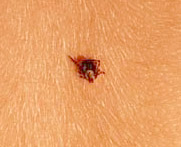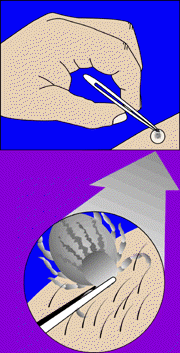Ticks pass diseases on to other animal
species, and there are many diseases that ticks can carry and pass on to
humans. In Montana, ticks are known to be disease carriers for:
Rocky
Mountain Spotted Fever
Colorado
Tick Fever
Tularemia
(commonly known as "rabbit fever")
Ticks like to crawl up on low vegetation
and wait for people or animals to brush up  against
them. Ticks become aroused by the odor and breathing of any nearby host
and transfer to humans or animals by stretching their legs toward the host.
Ticks do not fly or jump but crawl slowly. Ticks seldom attach to hosts
for several hours after contact. In Montana, tick season lasts from the
onset of warmer weather in the spring until about mid-July when warmer
weather and low relative humidity cause the ticks to become inactive. against
them. Ticks become aroused by the odor and breathing of any nearby host
and transfer to humans or animals by stretching their legs toward the host.
Ticks do not fly or jump but crawl slowly. Ticks seldom attach to hosts
for several hours after contact. In Montana, tick season lasts from the
onset of warmer weather in the spring until about mid-July when warmer
weather and low relative humidity cause the ticks to become inactive.
Rocky Mountain Spotted Fever
Rocky Mountain spotted fever is a serious,
generalized infection that is usually spread to people by the bite of infected
ticks. The disease gets its name from the Rocky Mountain area where it
was first identified. Rocky Mountain spotted fever is found throughout
the United States, except in Maine, Alaska, and Hawaii. Despite the name,
few cases are reported from the Rocky Mountain region. Most cases occur
in the southeastern United States. Rocky Mountain spotted fever is spread
by the American dog tick, the lone-star tick, and the wood tick, all of
which like to live in wooded areas and tall, grassy fields. The disease
is most common in the spring and summer when these ticks are active, but
it can occur anytime during the year when the weather is warm. Rocky Mountain
spotted fever is not spread from person to person, except rarely by blood
transfusion. Symptoms usually begin 3 to 12 days after a tick bite.
Without prompt medical care, kidney failure and shock can lead to death.
Rocky Mountain spotted fever must be treated with antibiotics. Many persons
with the disease need to be hospitalized.
COLORADO TICK FEVER
The disease is limited to the western
U.S. and is most prevalent during March to August during the tick season.
The incubation period is 3 to 6 days. Symptoms of fever continue for 3
days, then abate and recur 1 to 3 days later for another few days. Risk
factors are recent outdoor activity and recent tick bite. The incidence
is 4 out of 100,000 people.
TICK REMOVAL

The best way toremove
a tick is with fine-pointed tweezers. Grab as closely to the skin as possible
and pull straight back, using steady but gentle force.
-
Do not use your fingers
to remove the tick.
Do not twist the
tick, which can cause breakage, leaving part of its body in your skin.
Do
not squeeze, crush, or puncture the body of the tick because its fluids
(saliva, body fluids, gut contents) may contain infectious organisms.
-
Do not crush, prick,
or burn the tick, which may cause it to salivate or regurgitate infected
fluids.
-
Do not try to smother
the tick with products such as petroleum jelly or mineral oil. Ticks can
store enough oxygen to complete feeding.
-
After removing the tick, thoroughly disinfect
the bite site and wash your hands with soap and water.
-
Save the tick for identification in case you
become ill. This may help your doctor make an accurate diagnosis. Place
the tick in a plastic bag and put it in your freezer. Write the date of
the bite on a piece of paper with a pencil and place it in the bag.
Limiting exposure to ticks is the most effective
way to reduce the likelihood of tick bites. Careful inspection and removal
of crawling or attached ticks is an important method of preventing tick-borne
diseases. It may take several hours of attachment before organisms are
transmitted from the tick to the host.
Folklore remedies, such as the use of petroleum
jelly or hot matches, do little to encourage a tick to detach from skin.
In fact, they may make matters worse by irritating the tick and stimulating
it to release additional saliva or regurgitate gut
contents, increasing the chances of transmitting
the pathogen. These methods of tick removal should be avoided. A number
of tick removal devices have been marketed, but none are better than a
plain set of fine tipped tweezers.
TICK BITE PRECAUTIONS
-
Wear light-colored clothing to allow you to
see ticks that are crawling on your clothing.
-
Tuck your pants legs into your socks so that
ticks cannot crawl up the inside of your pants legs.
-
Apply repellants to discourage tick attachment.
Repellents containing permethrin can be sprayed on boots and clothing,
and will last for several days. Repellents containing DEET (n, n-diethyl-m-toluamide)
can be applied to the skin, but will last only a few hours before reapplication
is necessary. Use DEET with caution on children. Application of large amounts
of DEET on children has been associated with adverse reactions.
-
Conduct a body check upon return from potentially
tick-infested areas by searching your entire body for ticks.
-
Use a hand-held or full-length mirror to view
all parts of your body. Remove any tick you find on your body.
-
Parents should check their children for ticks,
especially in the hair, when returning from potentially tick-infested areas.
-
Additionally, ticks may be carried into the
household on clothing and pets. Both should be examined carefully.
PROPER DISPOSAL OF A
TICK
Place the tick in a
sealed container or small plastic bag and deposit in the trash. . Do not
flush ticks down the toilet because they can easily survive in the water.
Web sites with more
information:
US
Food & Drug Administration-Tick Information
Center
of Disease Control-Rocky Mountain Spotted Fever
Pictures
of ticks
Montana
State University Information on Ticks |